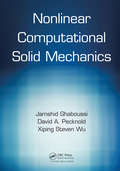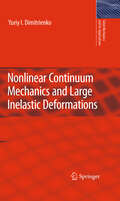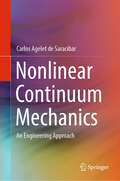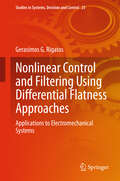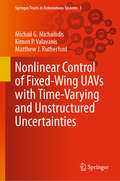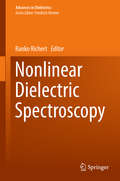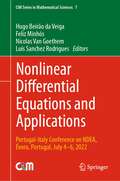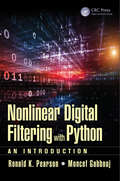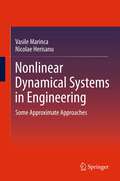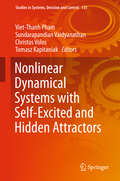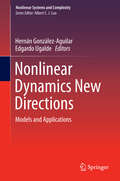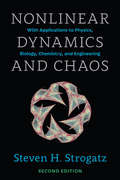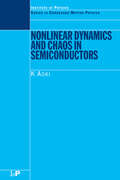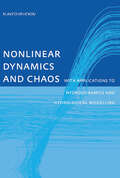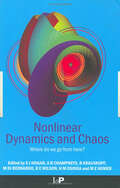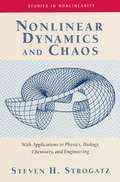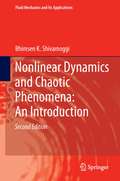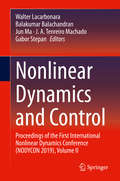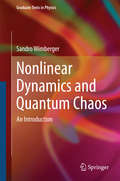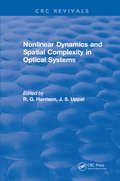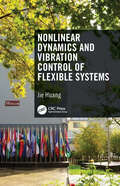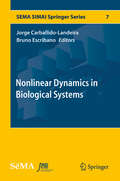- Table View
- List View
Nonlinear Computational Solid Mechanics
by Jamshid Ghaboussi David A. Pecknold Xiping Steven WuThis book presents the fundamentals of nonlinear mechanics within a modern computational approach based mainly on finite element methods. Both material and geometric nonlinearities are treated. The topics build up from the mechanics of finite deformation of solid bodies through to nonlinear structural behaviour including buckling, bifurcation and snap-through. The principles are illustrated with a series of solved problems. This book serves as a text book for a second year graduate course and as a reference for practitioners using nonlinear analysis in engineering and design.
Nonlinear Continuum Mechanics and Large Inelastic Deformations
by Yuriy I. DimitrienkoThe book provides a rigorous axiomatic approach to continuum mechanics under large deformation. In addition to the classical nonlinear continuum mechanics - kinematics, fundamental laws, the theory of functions having jump discontinuities across singular surfaces, etc. - the book presents the theory of co-rotational derivatives, dynamic deformation compatibility equations, and the principles of material indifference and symmetry, all in systematized form. The focus of the book is a new approach to the formulation of the constitutive equations for elastic and inelastic continua under large deformation. This new approach is based on using energetic and quasi-energetic couples of stress and deformation tensors. This approach leads to a unified treatment of large, anisotropic elastic, viscoelastic, and plastic deformations. The author analyses classical problems, including some involving nonlinear wave propagation, using different models for continua under large deformation, and shows how different models lead to different results. The analysis is accompanied by experimental data and detailed numerical results for rubber, the ground, alloys, etc. The book will be an invaluable text for graduate students and researchers in solid mechanics, mechanical engineering, applied mathematics, physics and crystallography, as also for scientists developing advanced materials.
Nonlinear Continuum Mechanics for Finite Element Analysis
by Javier Bonet Richard D. WoodDesigning engineering components that make optimal use of materials requires consideration of the nonlinear characteristics associated with both manufacturing and working environments. The modeling of these characteristics can only be done through numerical formulation and simulation, and this requires an understanding of both the theoretical background and associated computer solution techniques. By presenting both nonlinear continuum analysis and associated finite element techniques under one roof, Bonet and Wood provide, in the new edition of this successful text, a complete, clear, and unified treatment of these important subjects. New chapters dealing with hyperelastic plastic behavior are included, and the authors have thoroughly updated the FLagSHyP program, freely accessible at www. flagshyp. com. Worked examples and exercises complete each chapter, making the text an essential resource for postgraduates studying nonlinear continuum mechanics. It is also ideal for those in industry requiring an appreciation of the way in which their computer simulation programs work.
Nonlinear Continuum Mechanics: An Engineering Approach
by Carlos Agelet de SaracibarThis textbook on Continuum Mechanics presents 9 chapters. Chapters 1 and 2 are devoted to Tensor Algebra and Tensor Analysis. Part I of the book includes the next 3 chapters. All the content here is valid for both solid and fluid materials. At the end of Part I, the reader should be able to set up in local spatial/material form, the fundamental governing equations and inequalities for a Continuum Mechanics problem. Part II of the book, Chapters 6 to 10, is devoted to presenting some nonlinear constitutive models for Nonlinear Solid Mechanics, including Finite Deformation Hyperelasticity, Finite Deformation Plasticity, Finite Deformation Coupled Thermoplasticity, and Finite Deformation Contact Mechanics. The constitutive equations are derived within a thermodynamically consistent framework. Finite deformation elastoplasticity models are based on a multiplicative decomposition of the deformation gradient and the notion of an intermediate configuration. Different formulations based on the intermediate configuration, the current or spatial configuration, and the material configuration are considered. The last chapter is devoted to Variational Methods in Solid Mechanics, a fundamental topic in Computational Mechanics. The book may be used as a textbook for an advanced Master’s course on Nonlinear Continuum Mechanics for graduate students in Civil, Mechanical or Aerospace Engineering, Applied Mathematics, or Applied Physics, with an interest in Continuum Mechanics and Computational Mechanics.
Nonlinear Control and Filtering Using Differential Flatness Approaches
by Gerasimos G. RigatosThis monograph presents recent advances in differential flatness theory and analyzes its use for nonlinear control and estimation. It shows how differential flatness theory can provide solutions to complicated control problems, such as those appearing in highly nonlinear multivariable systems and distributed-parameter systems. Furthermore, it shows that differential flatness theory makes it possible to perform filtering and state estimation for a wide class of nonlinear dynamical systems and provides several descriptive test cases. The book focuses on the design of nonlinear adaptive controllers and nonlinear filters, using exact linearization based on differential flatness theory. The adaptive controllers obtained can be applied to a wide class of nonlinear systems with unknown dynamics, and assure reliable functioning of the control loop under uncertainty and varying operating conditions. The filters obtained outperform other nonlinear filters in terms of accuracy of estimation and computation speed. The book presents a series of application examples to confirm the efficiency of the proposed nonlinear filtering and adaptive control schemes for various electromechanical systems. These include: · industrial robots; · mobile robots and autonomous vehicles; · electric power generation; · electric motors and actuators; · power electronics; · internal combustion engines; · distributed-parameter systems; and · communication systems. Differential Flatness Approaches to Nonlinear Control and Filtering will be a useful reference for academic researchers studying advanced problems in nonlinear control and nonlinear dynamics, and for engineers working on control applications in electromechanical systems.
Nonlinear Control of Fixed-Wing UAVs with Time-Varying and Unstructured Uncertainties (Springer Tracts in Autonomous Systems #1)
by Kimon P. Valavanis Matthew J. Rutherford Michail G. MichailidisThis book introduces a comprehensive and mathematically rigorous controller design for families of nonlinear systems with time-varying parameters and unstructured uncertainties. Although the presented methodology is general, the specific family of systems considered is the latest, NextGen, unconventional fixed-wing unmanned aircraft with circulation control or morphing wings, or a combination of both.The approach considers various sources of model and parameter uncertainty, while the controller design depends not on a nominal plant model, but instead on a family of admissible plants. In contrast to existing controller designs that consider multiple models and multiple controllers, the proposed approach is based on the ‘one controller fits all models’ within the unstructured uncertainty interval.The book presents a modeling-based analysis and synthesis approach with additive uncertainty weighting functions for accurate realization of the candidate systems. This differs significantly from existing designs in that it is capable of handling time-varying characteristics. This research monograph is suitable for scientists, engineers, researchers and graduate students with a background in control system theory who are interested in complex engineering nonlinear systems.
Nonlinear Dielectric Spectroscopy (Advances in Dielectrics)
by Ranko RichertThis book introduces the ideas and concepts of nonlinear dielectric spectroscopy, outlines its history, and provides insight into the present state of the art of the experimental technology and understanding of nonlinear dielectric effects. Emphasis is on what can be learned from nonlinear experiments that could not be derived from the linear counterparts. The book explains that nonlinear dielectric spectroscopy can be used as a tool to measure structural recovery or physical aging, as well as connections between dynamics and thermodynamic variables such as enthalpy and entropy. Supercooled liquids in their viscous regime are ideal candidates for investigating nonlinear effects, because they are particularly sensitive to changes in temperature, and thus also to changes in the electric field. Other interesting materials covered are plastic crystals and complex liquids near criticality. The book also points out that, compared with other techniques such as mechanical shear experiments, the nonlinear regime of dielectric spectroscopy is special in the sense that the energies involved always remain small compared with thermal energies. To demonstrate this, nonlinear features of mechanical experiments are discussed. Theoretical approaches to nonlinear effects are particularly complicated because the tools available for the linear regime no longer apply. As a result, there is no single generally accepted theory to nonlinear dielectric responses of real liquids. Various approaches to nonlinear dielectric features have been reported, and the different aspects are communicated in several chapters. The book communicates recent progress most effectively through individual contributions from specialists in their respective fields.Chapter 'Third and Fifth Harmonic Responses in Viscous Liquids' is available open access under a Creative Commons Attribution 4.0 International License via link.springer.com.
Nonlinear Differential Equations and Applications: Portugal-Italy Conference on NDEA, Évora, Portugal, July 4–6, 2022 (CIM Series in Mathematical Sciences #7)
by Hugo Beirão da Veiga Feliz Minhós Nicolas Van Goethem Luís Sanchez RodriguesThis proceedings volume gathers selected, carefully reviewed works presented at the Portugal-Italy Conference on Nonlinear Differential Equations and Applications (PICNDEA22), held on July 4-6, 2022, at the University of Évora, Portugal.The main focus of this work lies in non-linear problems originating in applications and their treatment with numerical analysis. The reader will also find new advances on topics such as ordinary and partial differential equations, numerical analysis, topological and variational methods, fluid mechanics, operator theory, stability, and more.The Portugal-Italy Conference on Nonlinear Differential Equations and Applications convenes Italian and Portuguese researchers in differential equations and their applications to amplify previous collaboration and to follow and discuss new topics in the area. Reflecting the increasing teamwork involving the two mathematical communities, the conference has been opened to researchers from all nationalities.While researchers in analysis and related fields are the primary readership of this volume, PhD students can rely on this book as a valuable source to keep pace with recent advances in differential equations and cutting-edge applications.
Nonlinear Digital Filtering with Python: An Introduction
by Moncef Gabbouj Ronald K. PearsonNonlinear Digital Filtering with Python: An Introduction discusses important structural filter classes including the median filter and a number of its extensions (e.g., weighted and recursive median filters), and Volterra filters based on polynomial nonlinearities. Adopting both structural and behavioral approaches in characterizing and designing nonlinear digital filters, this book: Begins with an expedient introduction to programming in the free, open-source computing environment of Python Uses results from algebra and the theory of functional equations to construct and characterize behaviorally defined nonlinear filter classes Analyzes the impact of a range of useful interconnection strategies on filter behavior, providing Python implementations of the presented filters and interconnection strategies Proposes practical, bottom-up strategies for designing more complex and capable filters from simpler components in a way that preserves the key properties of these components Illustrates the behavioral consequences of allowing recursive (i.e., feedback) interconnections in nonlinear digital filters while highlighting a challenging but promising research frontier Nonlinear Digital Filtering with Python: An Introduction supplies essential knowledge useful for developing and implementing data cleaning filters for dynamic data analysis and time-series modeling.
Nonlinear Dynamical Systems in Engineering
by Nicolae Herisanu Vasile MarincaThis book presents and extend different known methods to solve different types of strong nonlinearities encountered by engineering systems. A better knowledge of the classical methods presented in the first part lead to a better choice of the so-called "base functions". These are absolutely necessary to obtain the auxiliary functions involved in the optimal approaches which are presented in the second part. Every chapter introduces a distinct approximate method applicable to nonlinear dynamical systems. Each approximate analytical approach is accompanied by representative examples related to nonlinear dynamical systems from to various fields of engineering.
Nonlinear Dynamical Systems with Self-Excited and Hidden Attractors (Studies In Systems, Decision And Control #133)
by Sundarapandian Vaidyanathan Christos Volos Viet-Thanh Pham Tomasz KapitaniakThis book highlights the latest findings on nonlinear dynamical systems including two types of attractors: self-excited and hidden attractors. Further, it presents both theoretical and practical approaches to investigating nonlinear dynamical systems with self-excited and hidden attractors. The book includes 20 chapters contributed by respected experts, which focus on various applications such as biological systems, memristor-based systems, fractional-order systems, finance systems, business cycles, oscillators, coupled systems, hyperchaotic systems, flexible robot manipulators, electronic circuits, and control models. Special attention is given to modeling, design, circuit realization, and practical applications to address recent research problems in nonlinear dynamical systems.The book provides a valuable reference guide to nonlinear dynamical systems for engineers, researchers, and graduate students, especially those whose work involves mechanics, electrical engineering, and control systems.
Nonlinear Dynamics New Directions
by Hernán González-Aguilar Edgardo UgaldeThis book, along with its companion volume, Nonlinear Dynamics New Directions: Models and Applications, covers topics ranging from fractal analysis to very specific applications of the theory of dynamical systems to biology. This first volume is devoted to fundamental aspects and includes a number of important new contributions as well as some review articles that emphasize new development prospects. The second volume contains mostly new applications of the theory of dynamical systems to both engineering and biology. The topics addressed in the two volumes include a rigorous treatment of fluctuations in dynamical systems, topics in fractal analysis, studies of the transient dynamics in biological networks, synchronization in lasers, and control of chaotic systems, among others. This book also: · Presents a rigorous treatment of fluctuations in dynamical systems and explores a range of topics in fractal analysis, among other fundamental topics · Features recent developments on large deviations for higher-dimensional maps, a study of measures resisting multifractal analysis and a overview of complex Kleninan groups · Includes thorough review of recent findings that emphasize new development prospects
Nonlinear Dynamics and Chaos
by Steven H. StrogatzThis textbook is aimed at newcomers to nonlinear dynamics and chaos, especially students taking a first course in the subject. The presentation stresses analytical methods, concrete examples, and geometric intuition. The theory is developed systematically, starting with first-order differential equations and their bifurcations, followed by phase plane analysis, limit cycles and their bifurcations, and culminating with the Lorenz equations, chaos, iterated maps, period doubling, renormalization, fractals, and strange attractors. A unique feature of the book is its emphasis on applications. These include mechanical vibrations, lasers, biological rhythms, superconducting circuits, insect outbreaks, chemical oscillators, genetic control systems, chaotic waterwheels, and even a technique for using chaos to send secret messages. In each case, the scientific background is explained at an elementary level and closely integrated with mathematical theory. In the twenty years since the first edition of this book appeared, the ideas and techniques of nonlinear dynamics and chaos have found application to such exciting new fields as systems biology, evolutionary game theory, and sociophysics. This second edition includes new exercises on these cutting-edge developments, on topics as varied as the curiosities of visual perception and the tumultuous love dynamics in Gone With the Wind.
Nonlinear Dynamics and Chaos
by Steven H. StrogatzAn accessible and clearly-written introduction for first-time students of chaos and nonlinear systems, with plenty of examples, illustrations, and applications to science and engineering. The theory is developed systematically, starting with first-order differential equations and their bifurcations, followed by phase plane analysis, limit cycles and their bifurcations, and culminating with the Lorenz equations, chaos, iterated maps, period doubling, renormalization, fractals, and strange attractors.
Nonlinear Dynamics and Chaos in Semiconductors (Condensed Matter Physics)
by K AokiThe field of nonlinear dynamics and low-dimensional chaos has developed rapidly over the past twenty years. The principal advances have been in theoretical aspects but more recent applications in a wide variety of the sciences have been made. Nonlinear Dynamics and Chaos in Semiconductors is the first book to concentrate on specific physical and ex
Nonlinear Dynamics and Chaos with Applications to Hydrodynamics and Hydrological Modelling
by Slavco VelickovThe theory of nonlinear dynamics and chaos, and the extent to which recent improvements in the understanding of inherently nonlinear natural processes present challenges to the use of mathematical models in the analysis of water and environmental systems, are elaborated in this work.
Nonlinear Dynamics and Chaos: Where do we go from here?
by Mario Di Bernardo John Hogan Bernd Krauskopf Eddie Wilson Alan Champneys Hinke Osinga Martin HomerNonlinear dynamics has been successful in explaining complicated phenomena in well-defined low-dimensional systems. Now it is time to focus on real-life problems that are high-dimensional or ill-defined, for example, due to delay, spatial extent, stochasticity, or the limited nature of available data. How can one understand the dynamics of such sys
Nonlinear Dynamics and Chaos: With Applications to Physics, Biology, Chemistry, and Engineering, Second Edition
by Steven H. StrogatzThis textbook is aimed at newcomers to nonlinear dynamics and chaos, especially students taking a first course in the subject. The presentation stresses analytical methods, concrete examples and geome
Nonlinear Dynamics and Chaotic Phenomena: An Introduction
by Bhimsen K. ShivamoggiThis book starts with a discussion of nonlinear ordinary differential equations, bifurcation theory and Hamiltonian dynamics. It then embarks on a systematic discussion of the traditional topics of modern nonlinear dynamics -- integrable systems, Poincaré maps, chaos, fractals and strange attractors. The Baker's transformation, the logistic map and Lorenz system are discussed in detail in view of their central place in the subject. There is a detailed discussion of solitons centered around the Korteweg-deVries equation in view of its central place in integrable systems. Then, there is a discussion of the Painlevé property of nonlinear differential equations which seems to provide a test of integrability. Finally, there is a detailed discussion of the application of fractals and multi-fractals to fully-developed turbulence -- a problem whose understanding has been considerably enriched by the application of the concepts and methods of modern nonlinear dynamics. On the application side, there is a special emphasis on some aspects of fluid dynamics and plasma physics reflecting the author's involvement in these areas of physics. A few exercises have been provided that range from simple applications to occasional considerable extension of the theory. Finally, the list of references given at the end of the book contains primarily books and papers used in developing the lecture material this volume is based on. This book has grown out of the author's lecture notes for an interdisciplinary graduate-level course on nonlinear dynamics. The basic concepts, language and results of nonlinear dynamical systems are described in a clear and coherent way. In order to allow for an interdisciplinary readership, an informal style has been adopted and the mathematical formalism has been kept to a minimum. This book is addressed to first-year graduate students in applied mathematics, physics, and engineering, and is useful also to any theoretically inclined researcher in the physical sciences and engineering. This second edition constitutes an extensive rewrite of the text involving refinement and enhancement of the clarity and precision, updating and amplification of several sections, addition of new material like theory of nonlinear differential equations, solitons, Lagrangian chaos in fluids, and critical phenomena perspectives on the fluid turbulence problem and many new exercises.
Nonlinear Dynamics and Control: Proceedings of the First International Nonlinear Dynamics Conference (NODYCON 2019), Volume II
by Jun Ma Walter Lacarbonara J. A. Tenreiro Machado Balakumar Balachandran Gabor StepanThis second of three volumes from the inaugural NODYCON, held at the University of Rome, in February of 2019, presents papers devoted to Nonlinear Dynamics and Control. The collection features both well-established streams of research as well as novel areas and emerging fields of investigation. Topics in Volume II include influence of nonlinearities on vibration control systems; passive, semi-active, active control of structures and systems; synchronization; robotics and human-machine interaction; network dynamics control (multi-agent systems, leader-follower dynamics, swarm dynamics, biological networks dynamics); and fractional-order control.
Nonlinear Dynamics and Quantum Chaos
by Sandro WimbergerThe field of nonlinear dynamics and chaos has grown very much over the last few decades and is becoming more and more relevant in different disciplines. This book presents a clear and concise introduction to the field of nonlinear dynamics and chaos, suitable for graduate students in mathematics, physics, chemistry, engineering, and in natural sciences in general. It provides a thorough and modern introduction to the concepts of Hamiltonian dynamical systems' theory combining in a comprehensive way classical and quantum mechanical description. It covers a wide range of topics usually not found in similar books. Motivations of the respective subjects and a clear presentation eases the understanding. The book is based on lectures on classical and quantum chaos held by the author at Heidelberg University. It contains exercises and worked examples, which makes it ideal for an introductory course for students as well as for researchers starting to work in the field.
Nonlinear Dynamics and Spatial Complexity in Optical Systems (Scottish Graduate Ser. #41)
by R. G. HarrisonA collection of prestigious postgraduate lectures, Nonlinear Dynamics and Spatial Complexity in Optical Systems reviews developments in the theory and practice of nonlinear dynamics and structural complexity, and explores modern-day applications in nonlinear optics. The book addresses systems including both singlemode and multimode lasers, bistable and multistable devices, optical fibers, counter-propagating beam interactions, nonlinear mixing, and related optical phenomena.
Nonlinear Dynamics and Vibration Control of Flexible Systems
by JIE HUANGThis book is an essential guide to nonlinear dynamics and vibration control, detailing both the theory and the practical industrial applications within all aspects of engineering. Demonstrating how to improve efficiency through reducing unwanted vibration, it will aid both students and engineers in practically and safely improving flexible structures through control methods. Increasing demand for light-weight robotic systems and space applications has actuated the design and construction of more flexible structures. These flexible structures, involving numerous dynamic systems, experience unwanted vibrations, impacting accuracy, operating speed, safety and, importantly, efficiency. This book aids engineers in assuaging this issue through vibration control methods, including nonlinear dynamics. It covers topics such as dynamic modeling of nonlinear system, nonlinear oscillators, and modal analyses of multiple-mode system. It also looks at vibration control methods including linear control, nonlinear control, intelligent control, and command smoothers. These control methods are effective and reliable methods to counteract unwanted vibrations. The book is practically minded, using industrial applications throughout, such as bridge cranes, tower cranes, aerial cranes and liquid sloshing. It also discusses cable-suspension structures, light-weight links, and fluid motions which exhibit flexible-structure dynamics. The book will be of interest to students and engineers alike, in the field of mechatronics, mechanical systems and signal processing, nonlinear dynamics, vibration, and control engineering.
Nonlinear Dynamics in Biological Systems
by Jorge Carballido-Landeira Bruno EscribanoThis book presents recent researchresults relating to applications of nonlinear dynamics, focusing specificallyon four topics of wide interest: heart dynamics, DNA/RNA, cell mobility, andproteins. The book derives from the First BCAM Workshop on Nonlinear Dynamicsin Biological Systems, held in June 2014 at the Basque Center of AppliedMathematics (BCAM). At this international meeting, researchers from differentbut complementary backgrounds, including molecular dynamics, physical chemistry,bio-informatics and biophysics, presented their most recent results anddiscussed the future direction of their studies using theoretical, mathematicalmodeling and experimental approaches. Such was the level of interest stimulatedthat the decision was taken to produce this publication, with the organizers ofthe event acting as editors. All of the contributing authors are researchers workingon diverse biological problems that can be approached using nonlinear dynamics. The book will appeal especially to applied mathematicians, biophysicists, andcomputational biologists.
Nonlinear Dynamics in Computational Neuroscience (PoliTO Springer Series)
by Fernando Corinto Alessandro TorciniThis book provides an essential overview of computational neuroscience. It addresses a broad range of aspects, from physiology to nonlinear dynamical approaches to understanding neural computation, and from the simulation of brain circuits to the development of engineering devices and platforms for neuromorphic computation. Written by leading experts in such diverse fields as neuroscience, physics, psychology, neural engineering, cognitive science and applied mathematics, the book reflects the remarkable advances that have been made in the field of computational neuroscience, an emerging discipline devoted to the study of brain functions in terms of the information-processing properties of the structures forming the nervous system. The contents build on the workshop “Nonlinear Dynamics in Computational Neuroscience: from Physics and Biology to ICT,” which was held in Torino, Italy in September 2015.
